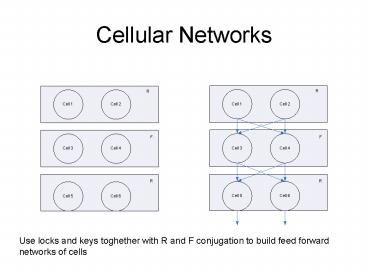Cellular Networks - PowerPoint PPT Presentation
Title:
Cellular Networks
Description:
Cellular Networks Use locks and keys toghether with R and F conjugation to build feed forward networks of cells Changing connection strength Graded response to input ... – PowerPoint PPT presentation
Number of Views:70
Avg rating:3.0/5.0
Title: Cellular Networks
1
Cellular Networks
Use locks and keys toghether with R and F
conjugation to build feed forward networks of
cells
2
Changing connection strength
Both connections of equal strength
Connection between cell1 and cell3 is stronger
3
Graded response to input
In liquid culture of 1/3 cellA 1/3 cellB, 1/3
cell2 expression of cell2s output is P(cellA
conjugating with cell2) Which in a well mixed
culture is proportional to the concentrations of
cellA and cell2
Pretend graph of output is here
Cell 2 produces output when it receives key 2
4
Graded response to input
In liquid culture of 1/3 cellA 1/3 cellB, 1/3
cell2 expression of cell2s output is Cell2 out
P(CellA OR CellB conjugating with cell2)
Pretend graph of output is here, higher output
than just A alone
Cell 2 produces output when it receives key 2
5
Inhibitory Signals
- Name of the protein that turns off the cell
pili to stop receiving input but still allow
output - Digest/Degrade output plasmid
- Conditional cell death
- RNA based competition for key binding sites
6
What we have
- Addressable communication
- Hierarchical network architecture
- Adjustable connection strengths
- Graded aggregate response to input
- Inhibitory signals
All the components required for a feed forward
neural network
7
Back Propagation Neural Network
Input signals propagate forward increasing
activity, both positive and negative
Error signals propagate proportionally backwards
returning activity to 0
8
General Node Design
Receive input from many inputs, send output to
many outputs, relay error from many outputs to
many inputs
9
Bacterial Neural Networks
- Massively Parallel
- Probabilistic
- Asynchronous
- Continuous time
- Can be tied into other pathways in cell or
environmental conditions - Highly adaptive, can grow additional nodes
- Complex behavior from simple, uniform node design
with different lock/keys































